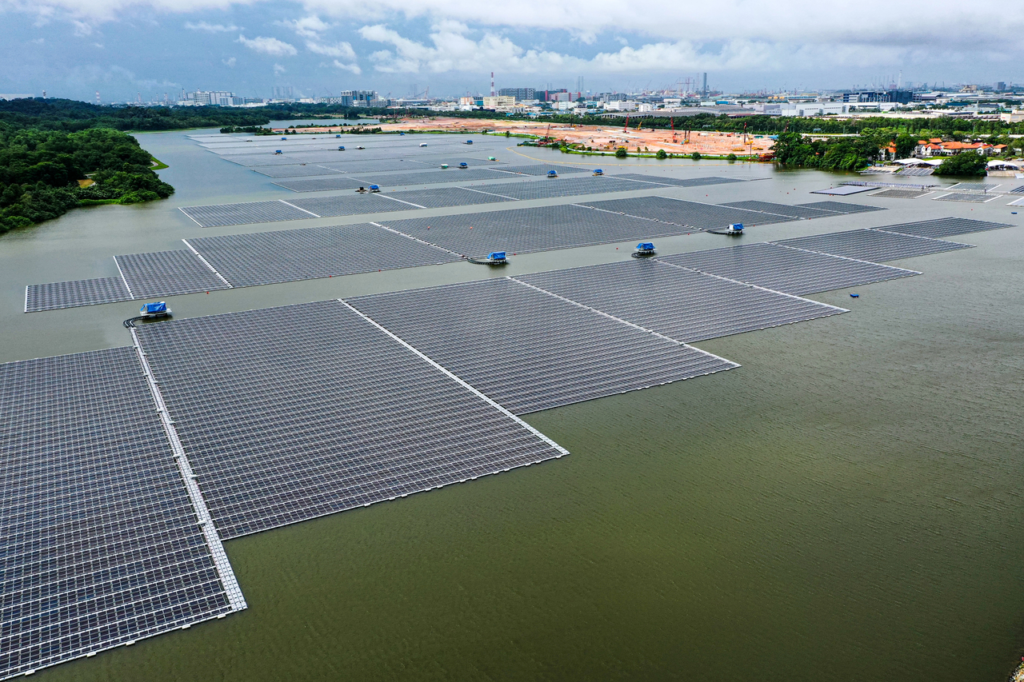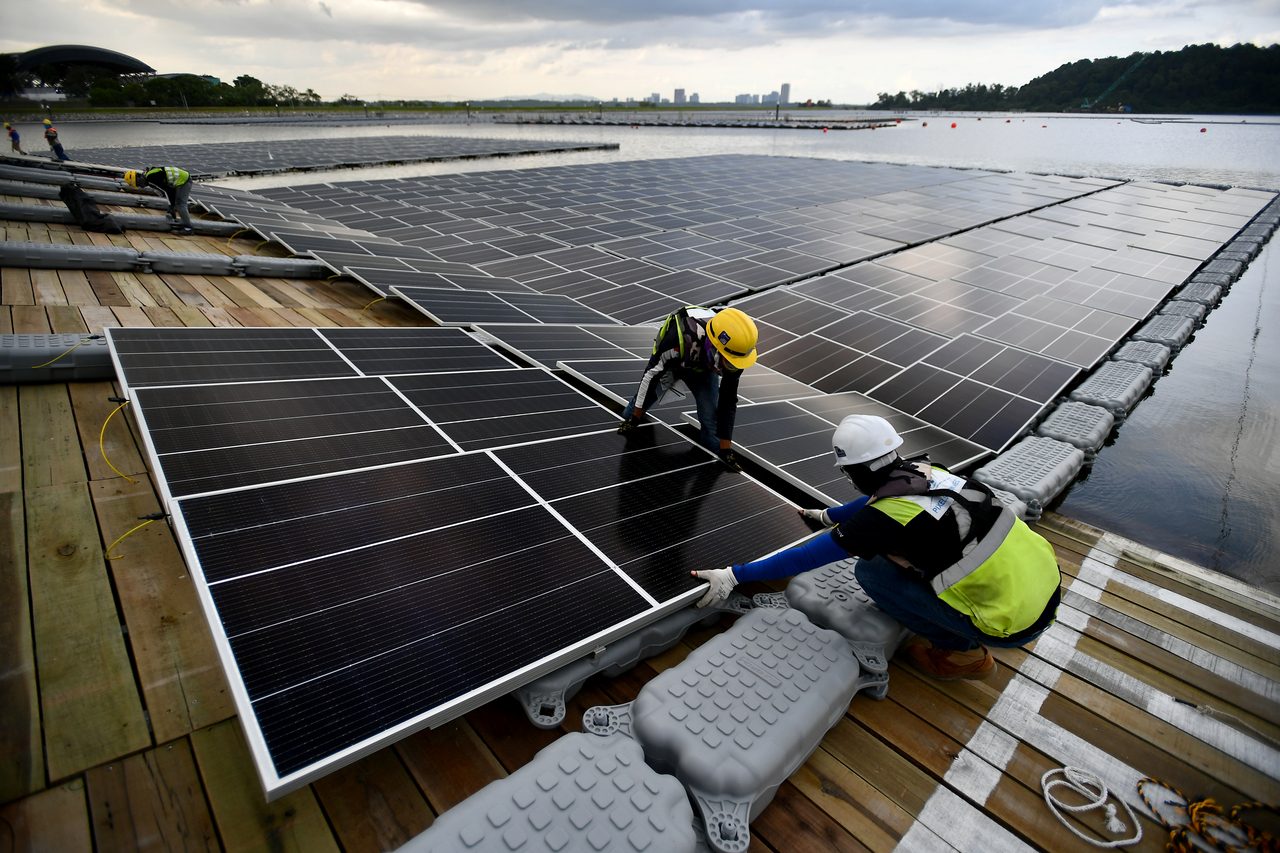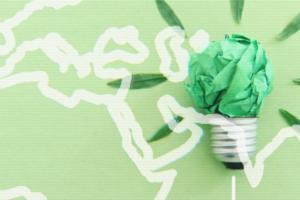Covid-19 may have caused delays to shipments of key equipment, but that has not derailed the timeline set out for building Singapore’s largest solar photovoltaic (PV) system to date.
Spread across 10 solar-panel islands – equivalent in size to 45 football fields – on the surface of Tengeh Reservoir, it is also one of the world’s largest inland floating solar PV systems.
It is set to be operationally ready in a few months, with national water agency PUB poised to tap the farm’s 122,000 solar panels to power its water treatment plants which convert reservoir water into drinking water.
The farm can produce enough electricity to power around 16,000 four-room Housing Board flats for a year.
Last year, solar PV systems generated only 0.56 per cent of the total electricity generated nationwide.
Then Trade and Industry Minister Chan Chun Sing, who is now Education Minister, announced a climate target – a quadrupling of solar energy capacity to 1.5 gigawatt-peak (GWp) by 2025.
That would power about 260,000 households annually, meeting about 2 per cent of Singapore’s projected electricity needs in 2025.
The target accelerates the country’s goal of deploying 2 GWp of solar energy by 2030.
Since 2015, the capacity of solar PV systems that have been contributing to the national grid has grown from around 60 megawatt-peak (MWp) to around 428 MWp at the end of last year.
This newest solar farm in Tengeh, which has a capacity of 60 MWp, will lead to carbon savings equivalent to removing 7,000 cars from the roads and contribute 4 per cent to the 2025 target.
Ms Chong Mien Ling, chief sustainability officer and director of policy and planning at PUB, said Tengeh Reservoir was chosen for this large-scale project because of its size. The farm occupies around a third of the reservoir’s surface.
Building the farm
PUB – Singapore’s water agency – will purchase clean energy generated by the farm from the national grid. The solar energy is not directly supplied to PUB’s infrastructure.
Energy company Sembcorp, which won the tender, took just about half a year to build the farm, with the bulk of the construction starting last December.
Ms Jen Tan, head of integrated solutions in Singapore and South-east Asia at Sembcorp Industries, told The Straits Times: “The beauty of a solar farm is that it has no moving parts. With a service lifespan of 25 years, this means that the farm should behave in the same way for the next 25 years if properly installed. No major maintenance is required.”
But the solar panels have natural degradation, with the power generated falling by 0.5 per cent to 0.6 per cent every year.
“So we are expecting the system to still be able to perform around at least 80 per cent of its original capacity at the end of 20 years,” said Ms Tan.
Being the first in Singapore to undertake such a large-scale project, Sembcorp faced a steep learning curve. “Early this year (amid the pandemic), assembling just 1,200 solar panels a day was difficult,” Ms Tan recalled.
The engineers then came up with their own techniques to boost productivity, such as by inventing a custom-built jig that saw the number of solar panels assembled peaking at around 1,800 to 2,000 a day.
A digital monitoring system will be set up to monitor the health of the solar farm. And as dirt on the panels can reduce operational efficiency, they are tilted at a slight angle to allow rainwater to wash off the dirt.
Drones with thermal-imaging capabilities will also be deployed to detect any faulty panels.
Environmental challenges
PUB said that as operationalising a sprawling solar farm may throw up environmental concerns such as the disruption of aquatic life, it took pre-emptive steps by looking into the feasibility of “solarising” Singapore from as early as 2011.
In 2015, the agency started studies to determine the potential impact on biodiversity and water quality of the reservoir, and subsequently started a 1 MWp solar testbed in Tengeh in 2016.
“We wanted to look at the impact on water quality, such as dissolved oxygen levels, nutrient levels and water temperature; how biodiversity is affected, if there is any noise generated and so on. We concluded that there was minimal impact,” Ms Chong said.
These studies gave PUB the confidence to scale up implementation of the panels, and in 2019, it invited private developers to come on board to install the Tengeh floating solar PV system.
Sembcorp also ensured sufficient gaps between the panels, facilitating good airflow and sunlight into the water.
Materials used to build the farm were carefully selected. For instance, the floats used are food-grade certified – meaning that they are non-toxic and safe for consumption. This prevents water quality from being compromised in the long term.
Nature groups were consulted, and the results of the environmental study were shared with them to allay their concerns.
The Tengeh solar farm intentionally avoided the south of the reservoir so as not to encroach on the nesting area of the grey-headed fish eagle, a near-threatened species.
“The farm was not built near that area to preserve the eagle’s habitat – an understanding which PUB has with the nature groups after we consulted them,” Ms Chong said.
In 2019, Sembcorp and Singapore Polytechnic also agreed to collaborate on researching and commercialising Singapore’s first solar panel recycling process. This involves extracting recyclable materials from parts of used solar panels after their lifespan of 25 years.
Powering the future
PUB is currently constructing two floating solar PV systems at Bedok Reservoir and Lower Seletar Reservoir, with each having a capacity of 1.5 MWp.
“We are also trying to maximise the solar PVs on our rooftops,” said Ms Chong.
Earlier in March, sustainable energy provider Sunseap Group announced that it had set up a sea-based floating 5 MWp system in the Strait of Johor, off Woodlands.
Meanwhile, Sembcorp is ready to scale up and build more farms. With a substantial amount of learning that came out of the Tengeh project, the company is confident about undertaking future projects of such scale, Ms Tan said.
Tweaks will be done as each environment is different and there is no one-size-fits-all design, she noted. For instance, whether the farm is out at sea or in a reservoir will determine the materials used as freshwater and seawater have different salinity levels.
“We have the knowledge, we know the challenges, how to mitigate them, and we intend to document all of these and apply it to other farms,” Ms Tan said.
The article was shared by The Straits Times as part of the World News Day initiative.





